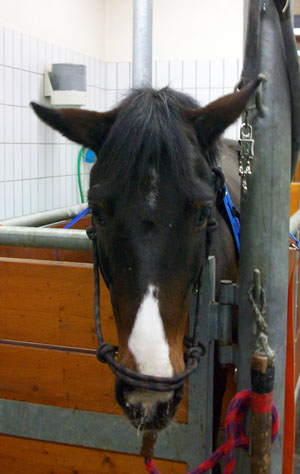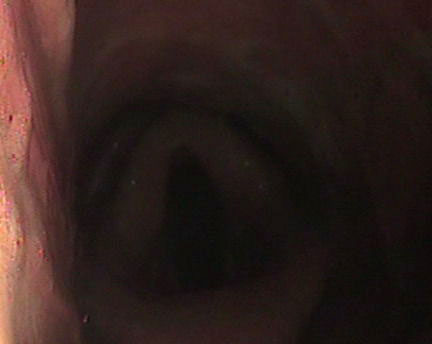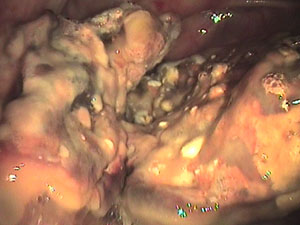15 years old Pony used for show jumping
History
The pony in regular training was found one morning with unilateral nasal discharge from the right nostril. The local veterinarian suspected a primary sinusitis, provided antibiotic coverage using ampicillin and performed a radiographic examination that was negative.
After one week of treatment with no improvement, the horse was referred to the clinic for further investigation.
Clinical examination
At admission the horse was alert with good bodily condition and excellent appetite. Body temperature and blood tests (PCV and WBC count) were normal.
Non purulent nor malodorous nasal discharge was present from the right nostril (Fig. 1).
 Fig. 1
Fig. 1
The right ear was lowered (Fig. 2).
 Fig.2
Fig.2
The horse was submitted to radiographic examination including several views to visualize the paranasal sinuses and tooth roots. No abnormal findings were detected.
The endoscopic examination revealed the presence of thick mucus at the inlet of the larynx and evidence of right laryngeal hemiplegia (Fig. 3).
 Fig. 3
Fig. 3
The mucus was particularly dense around the pharyngeal ostium of the right guttural pouch. The endoscope was advanced into the right guttural pouch where a large plaque presumably of mycotic nature covered the caudal vault of the medial compartment of the guttural pouch involving the hyoid bone and the internal carotid artery (Fig. 4 and 5).
 Fig.4
Fig.4
 Fig.5
Fig.5
The diagnosis was right sided guttural pouch mycosis.
The treatment proposed was local medical management using topic antimycotic powder and possibly surgical occlusion of the carotid artery to prevent fatal hemorrhage.
The owner declined the treatment because the horse was actually still owned by a German rider who elected to move the pony to a German clinic.
The owner reported later that the horse had started the medical treatment but eventually died of undetermined causes.
Comments
Guttural pouch mycosis is a relatively common and potentially fatal pathology. Clinical signs follow inflammatory and erosive effects of the fungal clusters affecting large arteries and nerves in the guttural pouch.
Early clinical signs may go unnoticed and only include moderate nasal discharge, like in the case described here. Later consequences are neurologic deficits like laryngeal hemiplegia (which was present in this case), dysphagia and Horner’s syndrome. Erosion of the arterial wall by the fungi may produce mild episodes of nasal hemorrhage frequently followed by large and fatal hemorrhage.
In case of early diagnosis – before any signs of hemorrhage – medical therapy may be started using topical antimycotic agents. This treatment is frequently successful against the mycosis but neurologic deficits, when present, rarely resolve. The surgical therapy, when successful, mostly prevents the fatal hemorrhage.
The surgical occlusion of the internal carotid artery may prevent the hemorrhage but does not resolve the mycosis and the subsequent neurologic damages.
